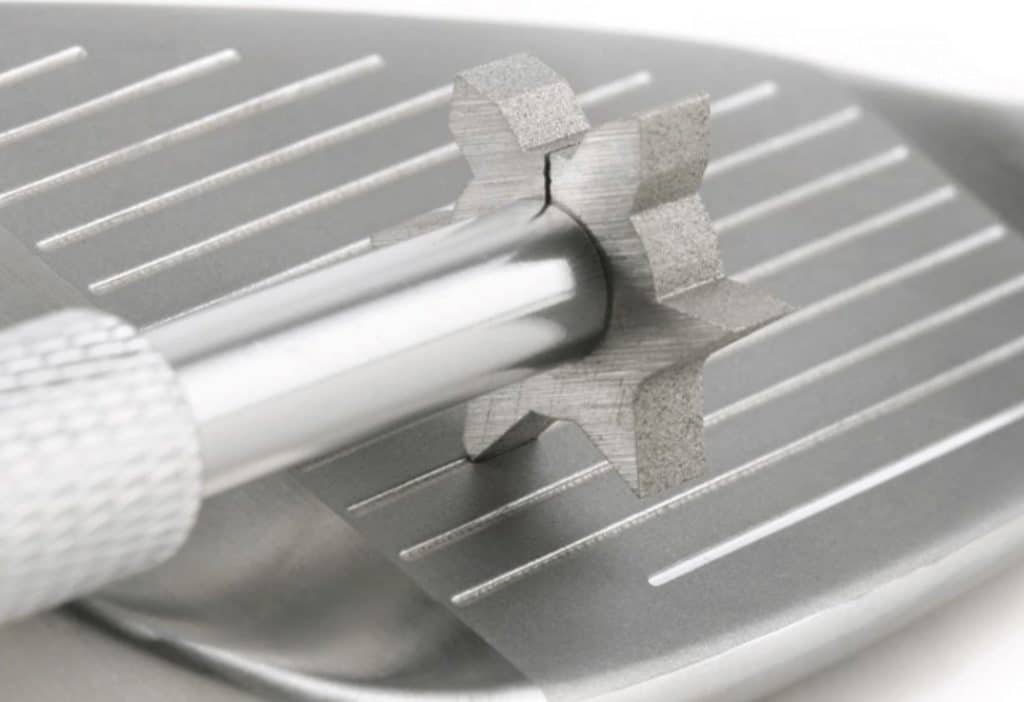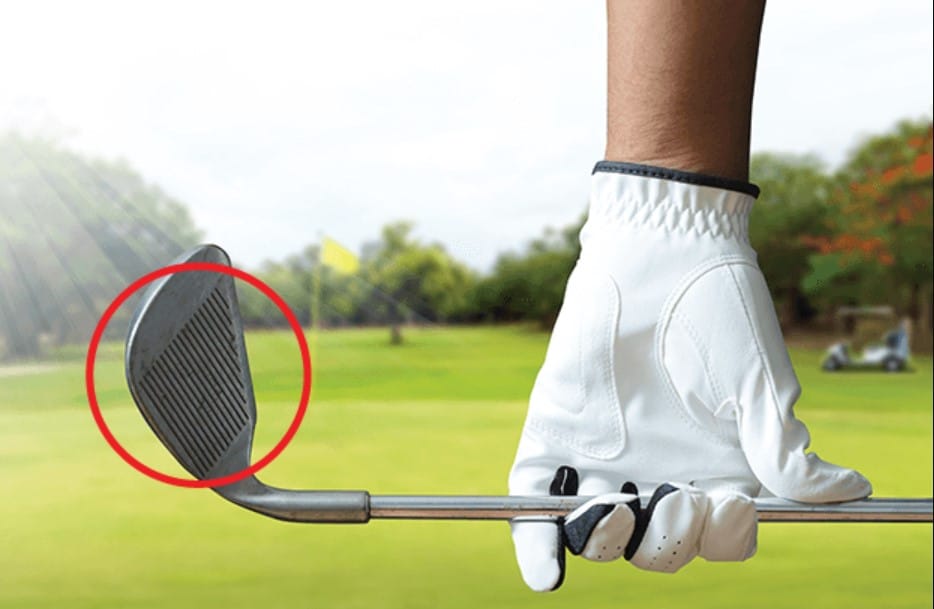Did you know that as your golf club grooves wear out: Your performance suffers? Initially, beginner and amateur golfers may not notice the difference between sharper and dull grooves. But as time goes by they may observe that they lose ball control when using their irons and wedges.
The grooves on the clubs are essential in ball control and backspin on the golf course. Groove sharpening might not be familiar to you. But you may consider it now as worn-out grooves will not provide you with the backspin and ball control you need.
So, one of the easiest ways of sharpening golf club grooves is as follows: Hold the groove sharpener like a pencil at a 45-degree angle to the face and draw it through the first groove.
Below is a detailed step-by-step instruction on how to sharpen golf club grooves. Check it out!
How to Sharpen Grooves on Golf Clubs

You can do simple cleaning on your clubs’ grooves. Deep cleaning includes sharpening grooves to make them as deep as the original. The task is a simple repair on the grooves of your golf clubs. The process usually takes less than ten minutes for every club.
Here are the detailed groove-sharpening steps you can do when you have spare time on the golf course.
Things you will need:
- Golf club sharpener
- Soapy water (preferably warm)
- Washing liquid detergent
- Electrical or masking tape
- WD-40 (or other lubricants)
- Dry & clean cloth
Step 1: Cleaning the club face
Mix soapy and warm water with two tablespoons of liquid detergent. Use this mixture to brush off oil and other dirt on the grooves. Get an old toothbrush or a scrub brush and clean your clubs. Remove the built-up dirt and debris between the grooves as much.
Ensure that the club face and the grooves are well-cleaned. Once the clubs are clean enough, wipe them with a clean cloth until dry.
Step 2: Protecting the club face
Before sharpening the grooves, put strips of electrical or masking tape at both ends of the canals (grooves). It will shield the club face from scratches. You might accidentally slip the sharpener beyond the grooves while doing the sharpening. The tape will protect the face from the sharp edges of the file.
Step 3: Do the re-grooving
Now, it is time for re-grooving. Get your sharpener and hold it by your fingers at a 45-degree inclination (like a pencil). Draw the sharpening tool at each groove gently, one slot at a time.
Do not use blunt force in running the sharpener at each groove. You can do the 45-degree incline drawing stroke at least five times on each groove or until it appears re-grooved.
Step 4: Have a vertical adjustment, if needed
You need to adjust the angle of contact between the sharpener blade and the groove. After drawing at 45 degrees, make the angle of contact at 90 degrees (vertical), then continue tapping the groove.
Continue drawing the sharpener back and forth at a perpendicular angle several times until you reach the earliest groove depth. But most groove sharpeners have a limited depth reach (restrictor) of 0.02 inches. This depth coincides with the USGA regulation.
Step 5: Lubricate the grooves, if necessary
Use lubricating oil (WD-40) when greasing the metal-to-metal contact of the sharpener and the groove. This way, you can avoid scratches on the groove while you repeat the process. Once the edges of the groove are clean, repeat the procedure on the succeeding grooves.
Tip: A tool kit that we always use in sharpening and cleaning our clubs is the VIPMOON Golf Clean Tool Set. The kit already includes a retractable brush with V-groove and U-groove sharpeners.
Should You Sharpen The Grooves On Your Golf Clubs?

Yes, you should. It is not necessarily you do it. You can hire a professional to do it for you. But if you decide to save a lot by doing it yourself (DIY), this guide is helpful.
Although sharpening the grooves of your clubs may not provide ball distance, it gives the ball added spin. Sharp grooves grip the ball well, and the additional spin will take you to more greens.
How to Sharpen Golf Grooves with a Screwdriver?
You can use a flat-head screwdriver to sharpen the grooves of your wedges. But be careful when doing the job. A screwdriver may dig deep into the groove because it has no restrictor like the commercial-grade groove sharpeners.
Pick a screwdriver that has the appropriate size suitable for the canal of the grooves. You can run the screwdriver back and forth into the grooves like a sharpener.
But we advise you to buy a re-grooving kit because it is not expensive. It is better to care for your expensive clubs with the appropriate sharpening and cleaning tools.
How Do You Sharpen Golf Grooves At Home?
There are two latest types of golf club grooves: the V grooves and the U grooves. Legal golf club groove sharpeners have six types of cutters; 3 V cutters and 3 U cutters. The former has deep and sharper grooves, while the latter is shallow with round edges.
If you are going to sharpen your clubs at home, know the type of grooves your clubs have. To determine if your clubs have the U or V grooves: You must have to contact the manufacturer.
Once you know your grooves, you can do sharpening at home doing the step-by-step instructions above. But clean the club head first before sharpening the grooves to get better results.
What Are Golf Club Grooves?
The grooves on golf clubs are similar to treads on car tires. The grooves allow the debris and water to have a room away from the golf ball’s contact point. Hitting the ball from roughs becomes unforeseeable if there is water or refuse between the club and the golf ball.
Why Are Golf Club Grooves crucial?
Golf club grooves are as effective as the treads on tires. They do not only separate the water and dirt on the club face from the ball: they even provide clean contact with efficient control. The grooves help make your shots more foreseeable.
Rules on Golf Club Grooves
The USGA 2008 ruling states that the groove width of all golf clubs (except putters) should not exceed 0.035 inches. This measurement is applicable in 50% or more measured grooves on your golf clubs on the bag. The rule also states that for any measured groove that exceeds 0.037 inches, the club is non-conforming.
The groove depth should not exceed 0.020 (0.508mm) inches for 50% or more of the measured groove depths. It also follows that any single measured groove depth should not exceed 0.022 inches. The depth ruling (for grooves) applies to all clubs except putters.
FAQ’s
Yes, it is legal to sharpen golf club grooves. But while it is legal, you have to conform to USGA regulations, as some rules about grooves described above. The re-grooving should be limited to restoring the original dimensions of the clubs and not enhancing their features.
Many respectable club manufacturers meet the standards set by the USGA. You do not have to tinker about the groove sharpness of your newly-bought clubs. If you do something not conforming to the regulations, think again! You might not utilize these clubs in tournaments ever again!
Metal-to-metal contact processes might damage your clubs if not utilized properly. If you plan to do the sharpening yourself, the golf club groove sharpener may dig deeper when used without care. So, read the instructions on the tool kit carefully.
Some best golf club groove sharpeners we recommend are the GrooveMaster Groove Sharpener and the Groove Doctor. Both brands are suitable for U and V grooves. But if you want a premium brand, try the Wedge Guys nU Groove Sharpener.
Yes, they work well when used correctly. Golf groove sharpeners work just fine in giving your wedges and irons the added spin.
Yes, it is legal. But like other sharpeners, the results should conform to USGA rules on groove width and depth. You should not overdo the sharpening if you do it yourself.
Read more: Best Golf Clubs for Beginners to Intermediates.
Conclusion
Now you know how to sharpen golf club grooves, you can do it in the comfort of your home or anywhere you find suitable. You can also consider the services of professionals if you can afford them. It is more recommendable than DIY, especially if you are an amateur or a beginner.
But once you do the re-grooving yourself, ensure that you have the proper tools. Re-grooving is essential to ensure your wedges and irons perform better in games. Our recommendation (as other golf experts agreed): you do the re-grooving at least every 15 to 20 rounds.
Matt Stevens is the founder of Golfrough.com. He holds a Postgraduate in Sports Marketing and has played golf since he was four years old. Having experienced every high and low golf has to offer, his writing helps the average golfer avoid the mistakes he has made in 28-years on the course.

